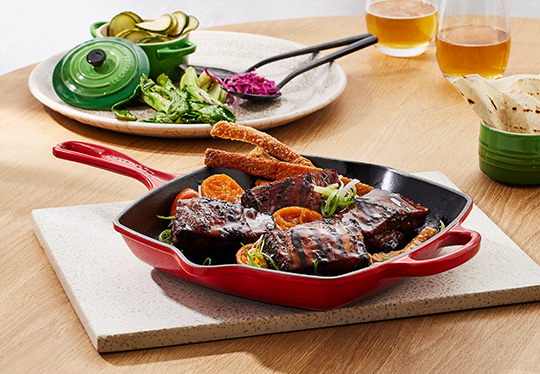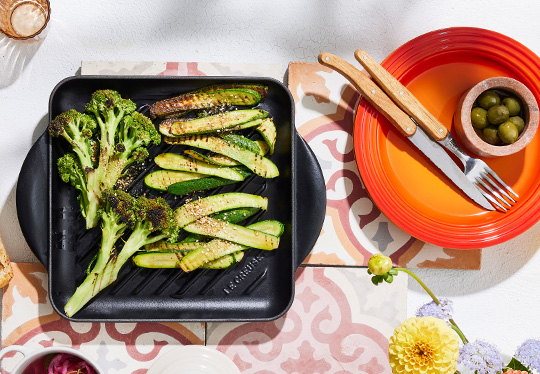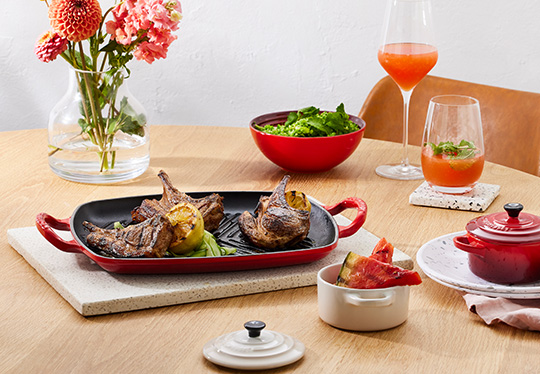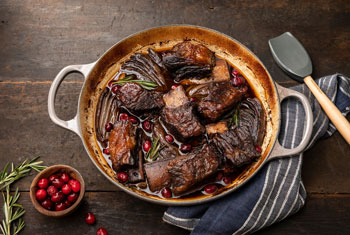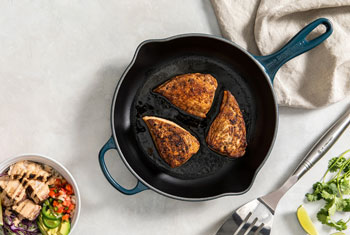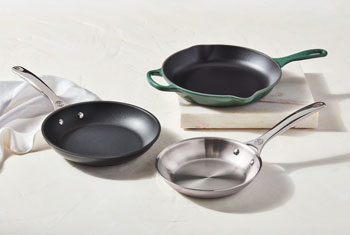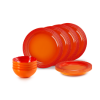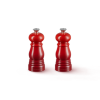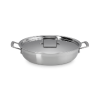Pan searing is one of the most essential cooking techniques in any chef’s repertoire and one of the best ways to add deep, rich flavour and texture to your food. It’s ideal for cooking just about everything, from juicy, golden-brown steaks and chops, to caramelised scallops and fish fillets, and even to vegetables like charred green beans and zucchini. Searing is usually the first step in braising and roasting recipes as well.
The best part is that searing is a quick and easy technique to master. So grab your Le Creuset skillet, frying pan, griddle or grill pan and read on for our best tips and techniques for how to sear – and even some pointers for how to prevent food from sticking to the pan.
Shop Skillets and Fry Pans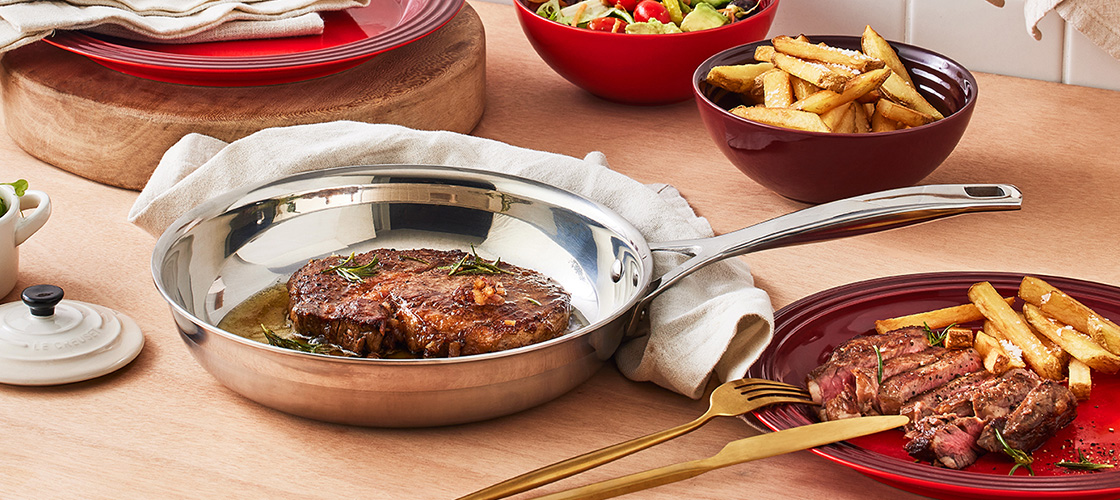
What is Pan Searing?
Simply put, pan searing is a cooking method used to create a delicious, savoury crust on the outside of food. By applying consistent heat, searing causes a reaction between the natural sugars and proteins in the food creating a golden-brown exterior with deep umami flavour. Contrary to popular belief, searing does not ‘seal in’ the juices. Instead, it caramelises the juices that the food releases while cooking, forming the richly flavourful crust. However, food that is seared properly will be juicier because this method cooks the food quickly without drying out the interior.
What is the Best Pan to Use for Searing?
To sear effectively, you need a pan that heats evenly and stays hot no matter how thick or thin the cut of meat or vegetable. This makes Le Creuset skillets and grill pans ideal for searing because of their exceptionally even heat distribution and retention. No matter whether you choose our enameled cast iron Signature Skillet, Griddle or Grill Pans, Signature Stainless Steel Frying Pans or even our Toughened Non-stick Frying Pans, they will heat up evenly and retain the heat consistently throughout the searing process for a perfectly uniform crust. This also means that you only need to use medium to medium-high heat for searing since the pan retains the heat.
All of our skillets, griddle, grill pans and fry pans are oven-safe as well, so they’re great for stove to oven to table recipes. For vegetables and thinner cuts of meat and fish you can likely keep the entire cooking process on the stove. But for thicker cuts and roasts or when braising, start the searing process on the stove and then finish cooking in the oven for perfectly tender results every time.
How to Sear and Prevent Food Sticking to the Pan
- Bring the food to room temperature - Food will get a stronger sear and cook more evenly when brought to room temperature before cooking. This is especially true for thicker cuts of meat like steaks, pork chops or bone-in cuts of poultry. It also helps prevent the food from sticking to the pan.
- Pat the food dry – Dry food produces an even crust with maximum flavor. Excess moisture on the meat will cause the liquids to steam and prevent searing. To prevent this, simply pat all sides dry with a paper towel.
- Season liberally – Add salt, pepper and any other seasonings on all sides of the food prior to cooking. This gives the salt time to penetrate the meat and draw in additional flavours. And by seasoning the food before you sear, you’ll get the added benefit of toasting the spices, bringing out even more flavour.
- Preheat the pan – Preheating ensures that when the meat is added to the pan it will stay hot and evenly sear across the entire surface. When using Le Creuset skillets, fry pans and grill pans, the empty pan can be preheated over medium heat for no more than 5 minutes before adding food.
- Use some kind of oil or fat – Unless you’re using a nonstick pan, you need to use some kind of oil or fat to grease the pan and prevent sticking. Use an oil with a higher smoke point such as grapeseed or canola so that the oil doesn’t smoke or burn. And use just enough oil to lightly coat the bottom of the pan and heat the oil just until it is shimmering but not smoking.
- Turn down the heat – Le Creuset skillets and pans retain heat exceptionally well. So you only need to use medium to medium-high heat for searing. One of the most common reasons that food sticks to our pans is using a heat setting that is too high. The heat level depends on your stovetop, so it might take a few tries to figure out your perfect level.
- Don’t crowd – If you are searing multiple cuts of meat at a time, make sure to leave about an inch of space between the pieces. If they are too close together, it will begin to produce steam which will cause liquid to run underneath the meat, preventing that delicious crust from forming.
- Sear undisturbed – Once you add the meat, resist the urge to touch or move it around to let the natural sugars caramelise and brown. Initially the food will appear to stick to the pan but will release naturally when it’s ready to be flipped.
- Flip and repeat - Each side need a few minutes of uninterrupted contact with the pan to properly caramelise. For steaks, chops and fish filets, you just have two sides to sear. But for large roasts, don’t forget to sear each and every side for maximum flavour.
- Use a thermometer – Cook until desired internal temperature is reached. An instant-read thermometer is the best way to tell when food is done.
- Deglaze with liquid –You can use any liquid for deglazing, but broth, wine or juice will add extra depth. The liquid removes all the delicious little browned bits on the pan, saving every last bit of flavour. This is the start of a pan sauce, braising liquid or gravy.



